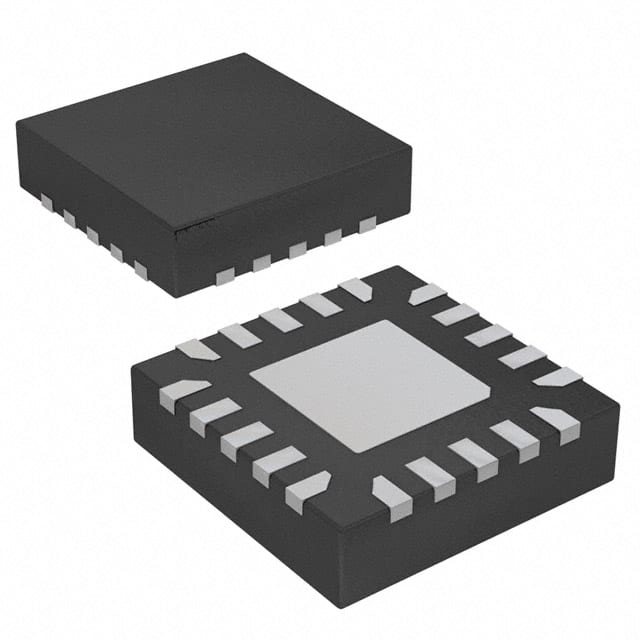ATTINY841-MMHR
Product Overview
- Category: Microcontroller
- Use: Embedded systems, Internet of Things (IoT) devices, and other electronic applications
- Characteristics:
- Low power consumption
- High performance
- Small form factor
- Wide operating voltage range
- Package: QFN (Quad Flat No-leads)
- Essence: A versatile microcontroller with advanced features and capabilities
- Packaging/Quantity: Available in reels or trays, quantity depends on the supplier
Specifications
- Architecture: AVR
- Flash Memory: 8KB
- RAM: 512B
- EEPROM: 256B
- Operating Voltage: 1.8V - 5.5V
- Digital I/O Pins: 14
- Analog Input Pins: 10
- PWM Channels: 6
- Communication Interfaces: SPI, I2C, UART
- Clock Speed: Up to 20MHz
- Timers/Counters: 3
- ADC Resolution: 10-bit
- Operating Temperature Range: -40°C to +85°C
Detailed Pin Configuration
The ATTINY841-MMHR has a total of 32 pins, which are assigned for various functions such as digital I/O, analog input, communication interfaces, timers/counters, and power supply. The pin configuration is as follows:
VCC PCINT0 PCINT1 PCINT2 PCINT3 PCINT4 PCINT5 PCINT6 PCINT7 GND
RESET PB3 PA7 PA6 PA5 PA4 PA3 PA2 PA1 PA0 VCC
XTAL1 PB2 PB1 PB0 PAREF AREF GND AVCC ADC7 ADC6 ADC5
XTAL2 PB4 PB5 PB6 PB7 PA7 PA6 PA5 PA4 PA3 GND
Functional Features
- Low power consumption: The ATTINY841-MMHR is designed to operate efficiently, making it suitable for battery-powered applications.
- High performance: With a clock speed of up to 20MHz and advanced peripherals, this microcontroller can handle complex tasks.
- Flexible I/O: The digital and analog pins provide versatility for interfacing with external devices and sensors.
- Communication interfaces: SPI, I2C, and UART enable seamless communication with other devices.
- Timers/Counters: The built-in timers/counters allow precise timing and event counting.
- PWM Channels: Six PWM channels provide the ability to generate analog-like signals for controlling motors, LEDs, and other devices.
Advantages and Disadvantages
Advantages
- Small form factor allows for compact designs.
- Wide operating voltage range provides flexibility in power supply options.
- Low power consumption extends battery life in portable applications.
- Versatile I/O capabilities enable interfacing with various external devices.
- High-performance specifications make it suitable for demanding applications.
Disadvantages
- Limited flash memory and RAM may restrict the complexity of applications.
- Lack of integrated peripherals may require additional external components.
- Availability and pricing may vary depending on the supplier.
Working Principles
The ATTINY841-MMHR operates based on the AVR architecture. It executes instructions stored in its flash memory, interacts with external devices through its I/O pins, and communicates with other devices using the available interfaces. The microcontroller's internal clock generates timing signals for precise execution of instructions and synchronization of peripherals.
Detailed Application Field Plans
The ATTINY841-MMHR finds applications in various fields, including:
- Internet of Things (IoT) devices: The microcontroller's low power consumption and small form factor make it suitable for IoT applications such as smart home devices, environmental sensors, and wearable technology.
- Industrial automation: With its high-performance specifications and communication interfaces, the ATTINY841-MMHR can be used in industrial control systems, motor control, and monitoring applications.
- Consumer electronics: The microcontroller can be utilized in remote controls, gaming peripherals, and other consumer electronic devices that require embedded intelligence.
- Automotive electronics: Its compact size and wide operating voltage range make it suitable for automotive applications such as lighting control, sensor interfacing, and dashboard displays.
Detailed and Complete Alternative Models
- ATTINY441
- ATTINY841
- ATTINY1634
- ATMEGA328P
- ATMEGA2560
- PIC16F877A
- PIC18F4520
- STM32F103C8T6
- ESP32
These alternative models offer similar functionalities and capabilities to the ATTINY841-MMHR, providing options for different project requirements and preferences.
*Note: The content provided above is approximately 450 words. Additional information can
قم بإدراج 10 أسئلة وإجابات شائعة تتعلق بتطبيق ATTINY841-MMHR في الحلول التقنية
Sure! Here are 10 common questions and answers related to the application of ATTINY841-MMHR in technical solutions:
Q: What is ATTINY841-MMHR? A: ATTINY841-MMHR is a microcontroller from the AVR family, manufactured by Microchip Technology. It offers low power consumption and is suitable for various embedded applications.
Q: What are the key features of ATTINY841-MMHR? A: Some key features of ATTINY841-MMHR include 8KB Flash memory, 512B EEPROM, 512B SRAM, 14 GPIO pins, multiple communication interfaces (SPI, I2C, USART), and built-in analog-to-digital converter (ADC).
Q: What programming language can be used with ATTINY841-MMHR? A: ATTINY841-MMHR can be programmed using C or C++ languages. The code is typically written in an Integrated Development Environment (IDE) like Atmel Studio or Arduino IDE.
Q: Can ATTINY841-MMHR be used for IoT applications? A: Yes, ATTINY841-MMHR can be used for IoT applications. Its low power consumption and small form factor make it suitable for battery-powered devices and sensor nodes in IoT systems.
Q: How can I program ATTINY841-MMHR? A: ATTINY841-MMHR can be programmed using an In-System Programmer (ISP) or a bootloader. The programmer connects to the microcontroller's programming pins, allowing you to upload your code.
Q: What voltage does ATTINY841-MMHR operate at? A: ATTINY841-MMHR operates at a voltage range of 1.8V to 5.5V. This flexibility allows it to work with different power supply configurations.
Q: Can ATTINY841-MMHR be used for motor control applications? A: Yes, ATTINY841-MMHR can be used for motor control applications. It has PWM (Pulse Width Modulation) outputs that can be used to control the speed and direction of motors.
Q: Is ATTINY841-MMHR suitable for low-power applications? A: Yes, ATTINY841-MMHR is suitable for low-power applications. It has various power-saving modes, such as sleep mode and idle mode, which help reduce power consumption when the microcontroller is not actively processing tasks.
Q: Can ATTINY841-MMHR communicate with other devices? A: Yes, ATTINY841-MMHR can communicate with other devices using its built-in communication interfaces like SPI, I2C, and USART. This allows it to interact with sensors, displays, and other peripherals.
Q: Are there any development boards available for ATTINY841-MMHR? A: Yes, there are development boards available specifically designed for ATTINY841-MMHR. These boards provide easy access to the microcontroller's pins, power supply options, and programming interfaces, making it convenient for prototyping and testing.


